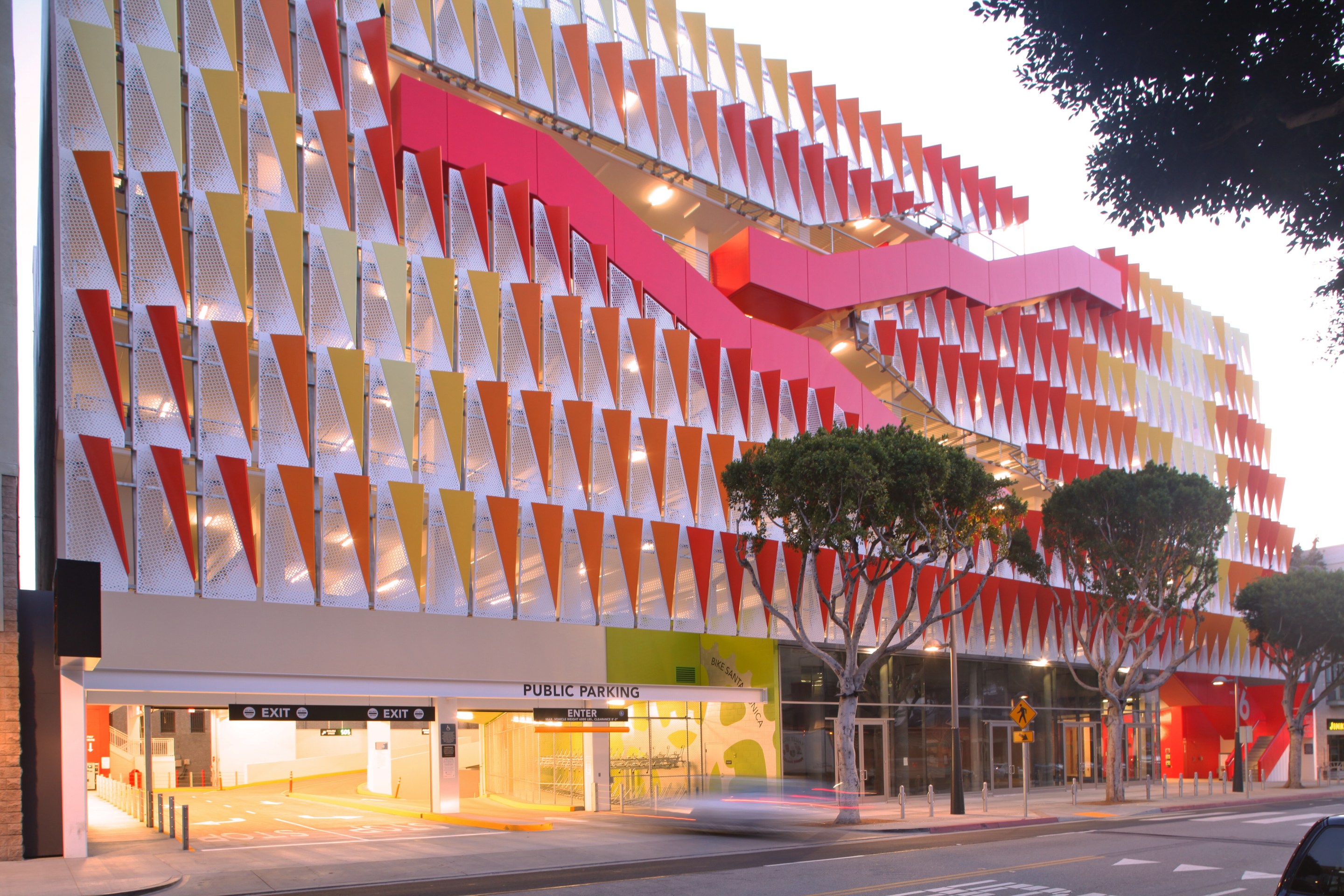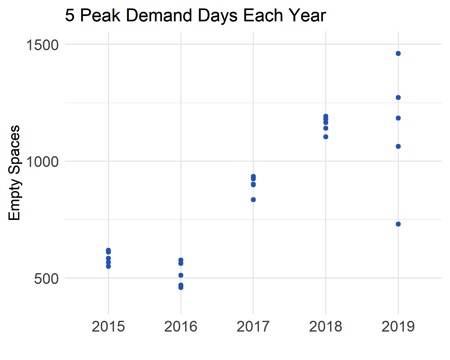This article first appeared at SBLA sister site Santa Monica Next.
While Santa Monica is as bustling as ever -- just ask the 8.7 million visitors the city hosted in 2017 -- the downtown parking structures are seeing fewer parkers and hundreds more free spaces each day.
We analyzed downtown parking structure data for Structures 1 through 9 and the Main Library reported to data.smgov.net to find out. Since 2015, on average the number of parking spaces available at the busiest times of each week has increased from about 1,100 spaces to 1,800. (Click here for the full methodology.)
That is, on busy days, 700 more empty spaces than only four years ago. About one-third of the parking spaces in the structures analyzed are empty at the times of peak demand!
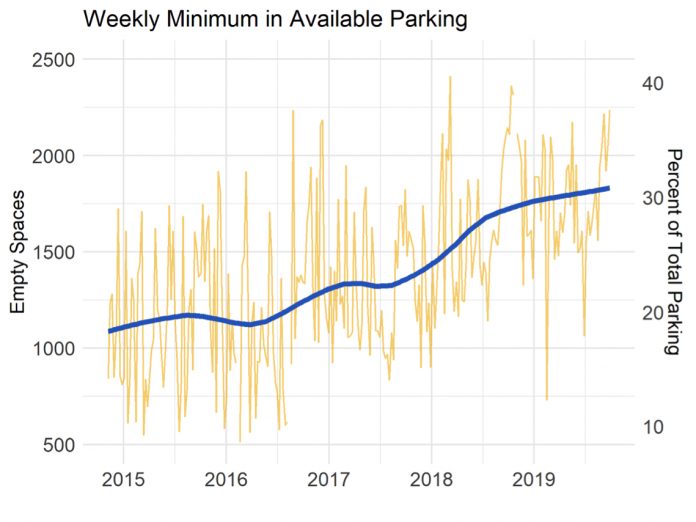
But the changes don’t just show up in the averages, let’s take the extremes. Look at how many spaces were still available at the peak moment on the five busiest days of each year from 2015 through 2019:
2015: 550, 567, 584, 611, 618 = 586 average spaces available on five busiest days
2016: 459, 470, 511, 563, 577 = 516 average spaces available on five busiest days
2017: 835, 899, 901, 1179, 1192 = 1,001 average spaces available on five busiest days
2018: 1104, 1141, 1165, 1179, 1192 = 1,156 average spaces available on five busiest days
2019: 731, 1063, 1185, 1272, 1461 = 1,142 average spaces available on five busiest days
One look at the 10 Freeway or surface streets is all you need to know that the cars haven’t disappeared. So why would we see parking in downtown Santa Monica decline over this time period? We didn’t attempt to tease out direct causation. But some possibilities reflect broader transportation trends that make it easier to get downtown without parking:
- Uber launched in Los Angeles in 2012 and Lyft launched in 2013
- The Expo Line opened to downtown Santa Monica in May 2016
- Bird scooters launched in fall 2017, followed by a city pilot with four operators and 3,000 permitted scooters in September 2018
- The rise of on-demand delivery: Food delivery services like Grubhub (2014), UberEats (2015) and Doordash (2018) launched or scaled up to the L.A. market, and AmazonPrime launched same-day shipping in 2016.
- Santa Monica parking structure rates increased incrementally and reduced free parking from two hours to 90 minutes.
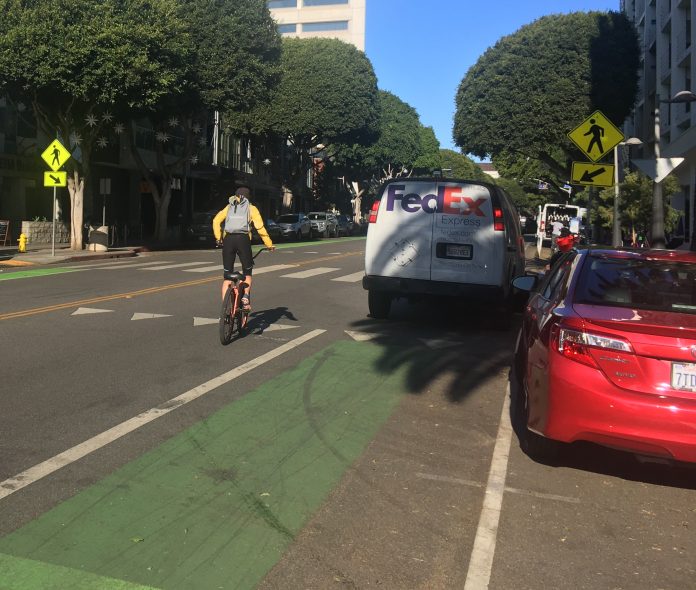
All of these represent seismic economic and social changes that either nudge people to come to downtown Santa Monica without a car that they then have to park, or to get a service from downtown (i.e. a HiHo Cheeseburger) without physically going downtown (via a food delivery service).
A call for safer streets
Recognizing that downtown Santa Monica now has an average of 1,800 empty spaces at the point of peak demand -- that’s 1 in 3 of all downtown structure spaces -- we can begin to envision what we could do if we began to repurpose some parking spaces in downtown, both in our structures and on our streets.
Imagine:
- Closing the gap in our family-friendly protected bike lane network by linking the Expo Line Path at 17th Street and Colorado to the beach path and Annenberg Beach House via Colorado Ave, Ocean Ave and the California Incline (76 spaces on Ocean Ave., 32 spaces on Colorado Ave.)
- Three new loading zones per block on 50 blocks of downtown for safe Uber, Lyft and food service pickups, which now happen in bike lanes due to lack of short term parking (150 spaces)
- Fifty new park parklets next to cafes and restaurants for alfresco sidewalk dining (50 spaces)
- Converting the top of one parking structure into a rooftop park (65 spaces)
- Repurposing parking on the Pier Deck to community gathering and activation space (277 spaces)
- Converting parking structure spaces into a staging zone for delivery services. Delivery trucks are increasingly occupying street space, often illegally parked, in busy cities. Imagine one large FedEx truck centrally drops a load that is delivered on its last mile by couriers driving electric cargo bikes (50 spaces).
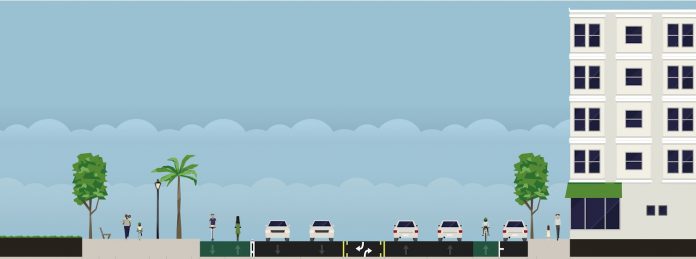
We can have all of this simply by repurposing 700 parking spaces in downtown Santa Monica that we literally, as the data show, no longer use even on busy days.
What the above also represents is a down payment on a sustainable future. An early salvo in a local Green New Deal that could help Santa Monica tackle its largest source of climate pollution - tailpipes from local cars.
So how do we do this?
As international parking luminary Donald Shoup famously wrote, there’s a high cost of free parking. Professor Shoup was referring to the fact that offering abundant cheap parking encourages people to drive, and leads to many social harms.
But in Santa Monica, we have 700 spaces of free parking, as in available parking spaces we no longer need. And the cost is the opportunity cost of squandering such a valuable resource.
We have 700 spaces of parking glut just compared to 2015, and to fail to put those spaces to use building a more healthy and sustainable city would be a terrible waste of free parking.
On November 12, the Santa Monica City Council will host a study session on the future of mobility in our community. On the docket will be an 18-month review of the pilot program to allow dockless scooters and bicycles.
This is precisely the time to ask: Are our streets serving how Santa Monicans have shown they want get around? And are they guiding us towards a future where we need to get by with even fewer gas-burning vehicles?
The answer is that we need to rethink our streets to better support people opting out of their cars, especially downtown, and opting out of parking even when they do come downtown in cars, i.e. taking an Uber or Lyft.
As we realize our success in decreasing parking demand while making Santa Monica an even more vibrant hub of social and economic life with investments in people-centered infrastructure, we can create a virtuous circle, continuing to free up ever more space for improving quality of life, supporting safe and equitable mobility, and building on and on in a virtuous cycle.
If you think now is a good time to reallocate some excess parking spaces to create a more livable city, consider sending a note to City Council to show your support for a more sustainable downtown and coming to the City Council meeting on the evening of November 12th.
Carter Rubin is an urban planner who lives and works in Santa Monica as a sustainable transportation advocate. Dustin Herrmann is an urban data scientist currently in the middle of a move from Covington, Kentucky to Santa Monica.
